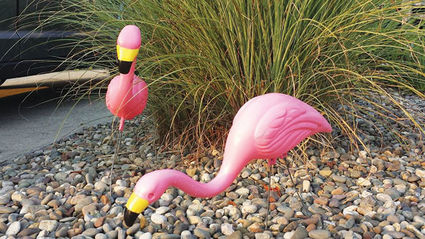Turf Removal Rebate Can Cover Cost of New Landscape
Water Matters
Maybe you thought about removing your lawn and putting in a low water use landscape with financial assistance from the Turf Removal Rebate, but were clueless how to go about it. Here is a plan for a low cost, low maintenance landscape with step-by-step directions and a budget. It is based on removing 1000 square feet of turf, meeting the program requirements, and receiving a rebate for the total cost of the new landscape. How simple is that?
Step one is to apply for the rebate online at http://www.saveourwaterrebates. com/, and wait for an email confirmation that you have received a rebate reservation of $xxxx. The rebate is based on $2 per square foot of lawn removed, so in our example, the rebate would be $2000.
Step two is to kill the turf. The low cost, low labor method would be using an herbicide like Roundup. Let's say four containers at $20 each = $80. There are better ways to deal with the lawn, but we're going for really easy. It won't be quick, it could take about a month and a half to kill all the grass. The caveats are the air temperature needs to be between 53 and 77o F, and the grass has to be alive and growing. So you may have to water your grass to kill it.
Step three, while the grass is dying, you could be ordering landscape materials. This estimate is based on a company that delivers to Tehachapi. The least expensive rock is lava rock at $35 per skip. A skip of landscape rock covers an area of 100 square feet two inches deep. We need 10 skips to cover 1000 square feet = $350. It just so happens that one truck can deliver 10 skips of lava rock for a cost of $120. Since this is the quick and easy low maintenance landscape, we will use landscape fabric, aka weed cloth, at 10 cents per square foot = $100.
The rebate program requires one tree and a minimum of 25% of the rebate area to be planted with low water use plants. We have chosen bullet proof native plants that grow wild on the nearby hillsides. The 25% of the rebate area is 250 square feet. The plant area is based on the mature size of the plant. Remember, the area of a circle is pi times radius squared. A blue oak (Quercus douglasii) will grow to 10 feet in diameter in the landscape. The radius of a circle is half of the diameter (10 foot diameter = 5 foot radius) and pi is 3.14. So the calculation is 3.14 X 5 squared (25) = 78.5 square feet. Our other plants are California buckwheat (Eriogonum fasciculatum) with a mature size of 3 feet diameter and great basin sage (Artemesia tridentata) at 4 feet diameter. Let's get two blue oak, 4 sage, and 6 buckwheat. That adds up to 248 square feet of mature plant area, close enough! Plants are the least expensive part at $8 per plant.
If you want to continue to use your irrigation system, you have to retrofit it for micro-irrigation. But since these are native plants that won't need irrigation after the first year, you can hand water them until they're established for just the cost of the water.
Let's see what this is adding up to:
Roundup $80
Lava rock $350
Weed cloth $100
Delivery $120
Plants $100
Contingency $100
Total cost of this project is only $850. Wow! You could even pay for labor to install the weed cloth and lava rock. You could even put in more plants, or flowering plants, or stepping stones, or a whole flock of plastic pink flamingos.
I hope this helps you think about participating in the turf removal rebate program. If you can't afford the cost up front, check out the HERO program for a retrofit loan (www.heroprogram.com/). And my help is free. Sign up for a landscape consultation (661) 822-5504 and let's get going!




